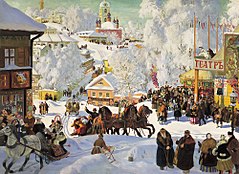Maslenitsa
| Maslenitsa | |
|---|---|
 Maslenitsa, Boris Kustodiev, 1919 (Isaak Brodsky Museum, St. Petersburg) | |
| Also called | Масленица |
| Observed by | Russian, Ukrainian, Bulgarian and Kazakhstan communities worldwide |
| Type | National |
| Significance | last week before Great Lent |
| Celebrations | Eating Blintz, snowball fights, sledding |
| Frequency | annual |
| Related to | Mardi Gras |
Maslenitsa (Russian: Ма́сленица, Ukrainian: Масниця, Belarusian: Масьленіца, Maślenica, also known as Butter Week, Crepe week, or Cheesefare Week), is an Eastern Slavic religious and folk holiday. It is celebrated during the last week before Great Lent—that is, the seventh week before Eastern Orthodox Pascha (Easter). Maslenitsa corresponds to the Western Christian Carnival, except that Orthodox Lent begins on a Monday instead of a Wednesday, and the Orthodox date of Easter can differ greatly from the Western Christian date.
Maslenitsa has its origins in both pagan and Christian traditions. In Slavic mythology, Maslenitsa is a celebration of the imminent end of the winter.
On the Christian side, Maslenitsa is the last week before the onset of Great Lent. During the week of Maslenitsa, meat is already forbidden to Orthodox Christians, making it a myasopostnaya nedelya (Russian: мясопостная неделя, English "meat-empty week" or "meat-fast week"). It is the last week during which milk, cheese and other dairy products are permitted, leading to its other name of "Cheese-fare week" or "Crepe week". During Lent, meat, fish, dairy products and eggs are forbidden. Furthermore, Lent also excludes parties, secular music, dancing and other distractions from the spiritual life. Thus, Maslenitsa represents the last chance to partake of dairy products and those social activities that are not appropriate during the more prayerful, sober and introspective Lenten season.
Traditions



The most characteristic food of Maslenitsa is bliny (pancakes or crepes). Round and golden, they are made from the rich foods still allowed by the Orthodox tradition that week: butter, eggs and milk.
Maslenitsa activities also include snowball fights, sledding, riding on swings and plenty of sleigh rides. In some regions, each day of Maslenitsa had its traditional activity: one day for sleigh-riding, another for the sons-in-law to visit their parents-in-law, another day for visiting the godparents, etc. The mascot of the celebration is usually a brightly dressed straw effigy of Maslenitsa, formerly known as Kostroma.
As the culmination of the celebration, on Sunday evening, Lady Maslenitsa is stripped of her finery and put to the flames of a bonfire. Any remaining blintzes are also thrown on the fire and Lady Maslenitsa's ashes are buried in the snow (to "fertilize the crops").
Religiously, the beginning of Great Lent is traditionally tied to the beginning of Spring, an association found in the Greek Triodion (containing hymns for the Lenten season), going back to at least a century before the Baptism of Rus—thus having no connection with pagan customs. The ancient hymns refer to the "Lenten Spring," a natural link because of the time of year during which Lent always occurs in the temperate regions of the Northern Hemisphere. The church services during this week are very similar to those served during Great Lent itself, though they are shorter. This is also the first time the Prayer of Saint Ephrem is said and the Divine Liturgy is forbidden on Wednesday and Friday (as it is on every weekday of Great Lent).
Sunday of Forgiveness
The last day of Cheesefare Week is called "Forgiveness Sunday", indicating the desire for God's forgiveness that lies at the heart of Great Lent.[1] At Vespers on Sunday evening, all the people make a poklon (bow) before one another and ask forgiveness, and thus Great Lent begins in the spirit of reconciliation and Christian love. Another name for Forgiveness Sunday is "Cheesefare Sunday," because for devout Orthodox Christians, it is the last day on which dairy products may be consumed until Easter. Fish, wine and olive oil will also be forbidden on most days of Great Lent. The day following Cheesefare Sunday is called Clean Monday, because everyone has confessed their sins, asked forgiveness, and begun Great Lent with a clean slate.
Modern Times
During Soviet times, Maslenitsa, like all the other religious holidays, was officially not celebrated. However, it was widely observed in families without its religious significance, just as an opportunity to prepare crepes with all sorts of fillings and coverings and to eat them with friends. After the start of perestroika, the outdoor celebrations resumed, although they were seen by some as an artificial restoration of a dead tradition. Many Russians have returned to practicing Christianity, however, so they are reviving the tradition.
Many countries with a significant number of Russian immigrants consider Maslenitsa a suitable occasion to celebrate Russian culture, although the celebrations are usually reduced to one day and may not coincide with the exact date of the religious celebrations.
See also

- Carnaval (in the Netherlands)
- Fat Thursday (in Poland)
- Mardi Gras (in other countries)
- Mărţişor (in Romania and Moldova)
- Martenitsa (in Bulgaria)
- Marzanna (in Poland)
- Patras Carnival (in Greece)
- Shrove Tuesday or "Pancake Day" (in the United Kingdom and Ireland)
- The Rite of Spring
References
- Marks, Gil (2010). "Encyclopedia of Jewish Food". Wiley. pp. 56–58. Retrieved April 18, 2012. ISBN 9780470391303
